E-Newsletter
Wolf Trap: A Fairfax County jewel that benefits citizens, visitors and business through arts and education
Fairfax County residents might know that Wolf Trap is the nation’s only national park for the performing arts. Perhaps they’ve attended a performance by a leading entertainer, enjoying the ambiance of the 7,028-seat Filene Center or relaxing on the adjacent lawn on a summer’s eve.
But there’s a lot more to Wolf Trap that makes it one of Fairfax County’s true treasures, not only enriching residents with a diversity of the arts but creating a world-class entertainment venue where visitors, businesses and their employees can not only revel but fully appreciate in their surroundings.
|
Wolf Trap provides world-class entertainment while enhancing the livability of Fairfax County.
|
Wolf Trap Foundation also oversees The Barns at Wolf Trap (an 18th-century, barn with intimate seating for 382), the Children’s Theater-in-the-Woods (an open-air, interactive setting where those ages 4-and-older are exposed to music, dance, storytelling and puppetry) and the Center for Education (one of the most vital elements Wolf Trap founder Catherine Filene Shouse envisioned when she bequeathed the site to the U.S. government in the 1960s).
To learn more, E-Bird Extra recently met with Arvind Manocha, president and CEO of Wolf Trap Foundation for the Performing Arts since January 2013. An expert in both artistic programming and operations management, Manocha is expanding the foundation’s vision of what Wolf Trap be, on stage, in the classroom and as a destination.
E-Bird Extra: What is the impact of being recognized as a National Park? How does the unique public-private partnership work?
Arvind Manocha: We at Wolf Trap Foundation are the private partner of the National Park Service in programming and bringing to life Wolf Trap National Park for the Performing Arts. To work with the National Park Service in helping steward a national and artistic resource is really an awesome responsibility.
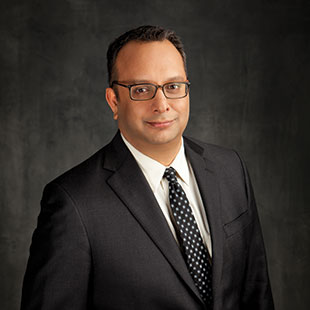 |
|
| Arvind Manocha, president and CEO, Wolf Trap Foundation for the Performing Arts. (Photos, WolfTrap.org) |
EE: How is it different from running a traditional entertainment venue?
AM: Being the only national park for the performing arts puts Wolf Trap in a really unique spot. While there’s’ a lot of great places to hear music, Wolf Trap is more than just the venue where you see the concerts. It’s over 100 acres of permanently-protected incredible green space with hiking trails and ponds and a theater in the woods for children. It belongs to all of us. It is part of that very proud national park tradition of maintaining and protecting the very best of America’s cultural and natural assets.
EE: In a nutshell, what separates Wolf Trap from other entertainment venues?
AM: Wolf Trap has so many unique attributes. We’re very open to people bringing their own picnics — food, wine, drink whatever you’d like. We really think of Wolf Trap as a place to choose your own adventure You can come and experience it in a way that makes sense for you. Lots of our patrons like to pack very elaborate picnics and sit out on our lawn. We also have restaurants and concessions on-site for those who don’t want to do the work at home and we have plenty of folks who like to come early and enjoy the natural beauty, especially if they have young families where they can really make a day of it.
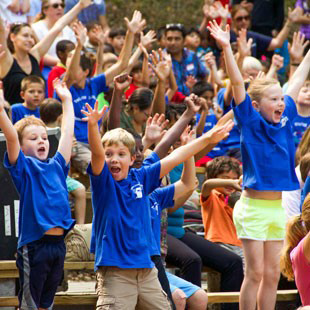 |
|
|
Wolf Trap’s Theater-in-the-Woods is one of several foundation programs catering to young people and their education.
|
EE: Can you outline some of the educational opportunities that take place through Wolf Trap?
AM: At the Wolf Trap Foundation we offer programs that run the gamut from early childhood programs for very, very young people all the way up through our college internship programs as well as music lessons for adults in the area … We engage master teaching artists to work in classrooms with teachers with art strategies to bring to life whatever curricular objectives they might have. We do that here in Fairfax County our oldest and strongest partner, the Fairfax County Public School System, as well as throughout the DMV and increasingly throughout the Commonwealth of Virginia and across the country. We actually have 18 partner sites using the Wolf Trap method around the nation and we’re proud to say we’ve started the first international outpost of Wolf Trap in Singapore.
EE: How exactly does educational outreach play out locally?
AM: Our teaching artists work with Fairfax County Public Schools teachers to help bring art strategies into their classrooms in ways that are sometimes unexpected. For example, we have a STEM program through the arts where preschoolers are learning about the building blocks of arithmetic or science and doing it through music and dance. Because kids at that age like to learn by doing — by acting out, by becoming — we find that using music and storytelling and puppetry are very, very effective ways for them to absorb sometimes complicated concepts.
EE: How does Wolf Trap support itself?
AM: Wolf Trap Foundation relies on a lot of different income streams to make all of this come to life. Of course we have our concert business in Wolf Trap National Park and at the Barns, but ticket sales only cover 50 percent of our operating budget. The rest comes mainly from philanthropy. We rely on philanthropic gestures of individuals and corporations and foundations in the area and across the country to help bring our programs to life.
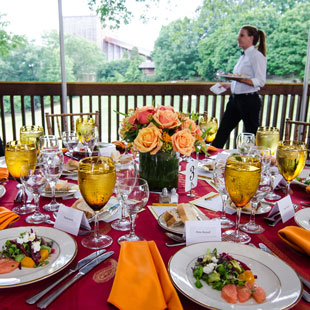 |
|
| Wolf Trap offers on-site dining and hospitality options for shows and private events. |
EE: What about other on-site opportunities such as site rental, events and catering?
AM: At The Barns and at our Center for Education, we host many kinds of private events, from weddings and bar mitzvahs to birthday parties and corporate retreats. Especially at The Barns of Wolf Trap, we find that the community really enjoys being in our historic space. It’s very intimate and provides an unusual backdrop. Of course, over at the National Park, prior to concerts, we often host corporations or alumni associations for private events on our decks overlooking our meadow.
EE: Tell us about what you consider the most innovative aspect about Wolf Trap.
AM: I think a lot of it is about being able to create your own experience — to be very personalized with how you interact with the space and be very free to create a Wolf Trap evening that makes sense for you. I see audiences of today wanting to pick and choose and customize and curate their artistic consumption. I think that’s something we’ve been doing for quite a long time and I especially see it with millennials who come to the park and understand that they can really make this their own Wolf Trap experience.
EE: What makes Vienna such a great location for Wolf Trap?
AM: We’re very fortunate to be located in Vienna, Virginia and in this particular slice of Northern Virginia in general. Whether you are in Vienna, the Tysons area, the Reston corridor or further west, you see a community which is growing, which is diversifying, where corporations are moving and where people are moving to take residence. And I see us as an urban oasis probably more needed than ever.
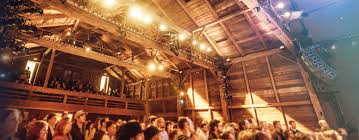 |
|
| The Barns at Wolf Trap offers an intimate, year-round setting for a variety of performances. |
EE: In general, where do celebrities stay when they come to town? How do you insure their comfort?
AM: I think our artists really enjoy coming to Wolf Trap for a lot of reasons — partially because they see the grandeur of the space. I think people are very appreciative that it’s the only national park for the performing arts and of everything that implies. We have a lot great hospitality options in the Northern Virginia region, particularly in Tysons Corner. Our visitors are just steps away from Tysons and the nation’s capital, so it makes for a nice tour stop. We try to make our artists feel very at-home and relaxed. Being on the road makes for a grueling schedule. Our hospitality team takes great efforts to think about the interests and the needs of each of our performers — which are unique. We have a game room back-stage and other places for them to relax on-site, so they can really feel they can be at home.
EE: We see you’ve lined up everyone from Diana Ross and Tony Bennett to Reba and Ringo Starr. How does this year’s featured schedule compare with previous years?
AM: The season is going to be action-packed from start to finish. We’re very much looking forward to kicking off the season with three nights of the Avett Brothers (May 23-25). We’ve never opened with a three-night stand before. We’re very proud that we’re bringing the American Ballet Theater back (July 11-13) including Misty Copeland dancing the lead role in “Swan Lake” for the first time at Wolf Trap. We have three nights with Sting later in the season (Aug. 26-28) and a whole wide variety of international and national artists from across the spectrum. Every year there’s a large number of first-timers. We’re very happy this year that Kasey Musgraves is making her headline debut at Wolf Trap at the very end of the season (Sept. 7).
> For Wolf Trap’s complete summer schedule, click here.
EE: What goes into creating a lineup that’s pleasing to the masses? Is there any particular audience that is difficult to please?
AM: When we put together the season, we try to balance a lot of different things. Because we are ‘owned’ by the people — because we are a national park — we want to make sure that everyone in Fairfax County who opens the schedule sees something on there for them, which means we try to be very diverse, very inclusive. We try to be representative of all different traditions of music, whether it be traditional Middle East dancing or R&B to opera, to country or straight-ahead classic rock. We really do try to cover a wide spectrum.
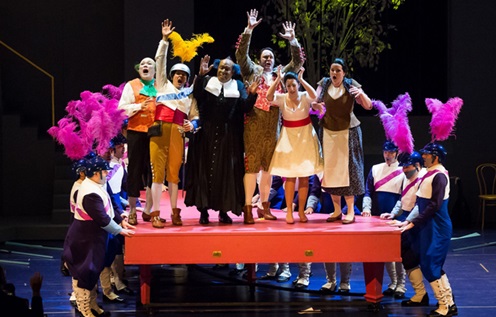 |
|
| Opera is a mainstay on Wolf Trap’s schedule of events. |
EE: What would be a couple of your favorite moments from recent seasons?
AM: We’ve had so many memorable events in the six seasons I’ve been here. I think about some of our produced opera. We don’t really get fully-staged opera in an outdoor theater of this size anywhere else in the country, so those are very special events at Wolf Trap every summer. I’m thinking about last year when Lady Gaga came out and sang with Tony Bennett, unannounced and unpromoted. I think about Yo-Yo Ma’s return visit. I think about my very first season and first concerts and I think about everyone who comes to Wolf Trap to see something that they really don’t forget for the rest of their lives.
EE: What are your greatest concerns? What keeps you up at night?
AM: When you’re in the live music business there’s a lot that keeps you up at night because there are a lot of variables you can control and a lot of variables you can’t control. Of course, weather is one of them … But the things I think about are the same things other arts leaders and venue managers think about, which are sustainability, relevance, making sure we are creating relationships among people who will be around to support Wolf Trap in the future. Northern Virginia is a great place to be a music lover because of an abundance of riches. So, if you live in Northern Virginia, we want to make sure that Wolf Trap continues to be at the very top of mind when people think of an evening out.
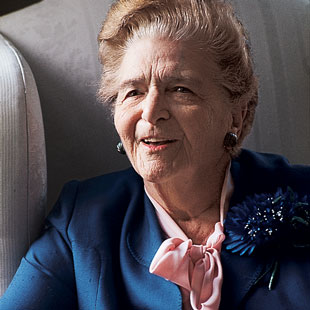 |
|
|
The generosity and vision of Catherine Filene Shouse made Wolf Trap’s National Park setting a possibility in Vienna.
|
EE: What changes have you recently implemented and what might the future hold?
AM: There have been some significant changes, the most notable of which is the installation of our enormous image magnification screens throughout the park last year. So, the lawn experience is a dramatically different experience than it was even two years ago. With two screens in-house and three on the lawn, it’s really transformed the way people interact with the concerts. Some other changes I think you’ll see at Wolf Trap are not dissimilar to what you see in your life, (one of which) is the rise of mobile. Everything that we’re doing online, whether it be getting information to patrons, digital program books, easier ticketing methods, ways to think about planning your visit here and supporting us in education — the mobile site has really become the go-to. Ten years from now, I think you’re going to see that Wolf Trap continues to program across a broad spectrum. Of course, we’ll also see new technologies, new amenities, so we need to continue to evolve and change. The experience is unpredictable. We’re not going to know what technology is going to bring us, but we know we’ll be participating with whatever that is.
 |
| A summer evening event packs the lawn at Wolf Trap. |
Fast facts: A handicap accessible facility, Wolf Trap’s three major venues host more than 150 concerts and shows per year, drawing about 400,000 patrons to Vienna … Wolf Trap is operated as a public-private partnership between the National Park Service, which maintains the grounds, and the Wolf Trap Foundation, which oversees artistic, education and administrative programs … Inaugural performances at the Filene Center took place June 1-2, 1971 and featured Van Cliburn, Julius Rudel conducting the New York City Opera with Norman Treigle, and performances by the National Symphony Orchestra, Choral Arts Society of Washington, U.S. Marine Band and the Madison Madrigal Singers.
Contact: The Filene Center at Wolf Trap National Park for the Performing Arts is located at 1551 Trap Road, Vienna, VA 22182. General information: 703-255-1900, wolftrap@wolftrap.org; Purchase tickets: 1-877-WOLFTRAP; Education outreach: 703-937-6304, education@wolftrap.org
News Travels Fast
Stay ahead of the curve with the latest business news from Northern Virginia. Receive updates on moves, incentives, workforce, events and more.
